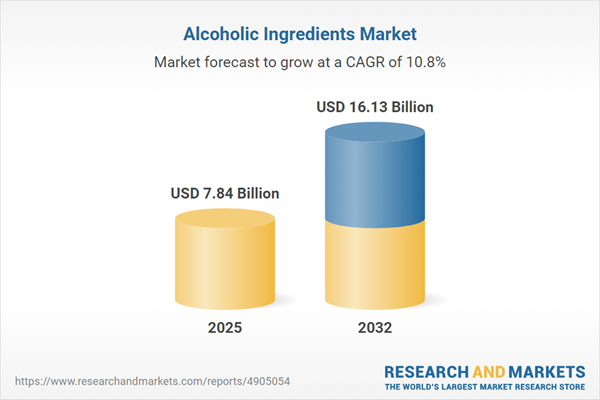Speak directly to the analyst to clarify any post sales queries you may have.
Senior leaders face a complex landscape in the alcoholic ingredients market, requiring a constant balance between compliance, innovation, and evolving consumer expectations. Successful executives steer operations by anticipating change, managing risk, and driving sustainable value creation.
Market Snapshot: Alcoholic Ingredients Market Size and Growth Dynamics
The alcoholic ingredients market is set for significant expansion, underpinned by a projected compound annual growth rate (CAGR) of 10.84% from 2024 to 2025. During this timeframe, global market value is expected to rise from USD 7.08 billion to USD 7.84 billion. Long-term projections show continued growth, reaching USD 16.13 billion by 2032. The primary growth enablers include ongoing product innovation, elevated demand for diverse flavor profiles, and an increased emphasis on quality, sustainability, and safety within the value chain. Leadership must proactively address regulatory changes and supply chain instability, adopting agile strategies to sustain business performance without overlooking the opportunities presented by new trends and operating models.
Scope & Segmentation: Detailed View of the Alcoholic Ingredients Market
This market report delivers clear, actionable insight to aid senior executives in optimizing operations and procurement across a multifaceted value chain. The main segmentation categories offer pathways for differentiation and resilience:
- Application Categories: Beer, spirits, wine, ready-to-drink beverages, and cider channels allow for tailored product strategies aligned with consumer preferences and branding objectives.
- Beer Types: Mainstream and craft segments such as ales, lagers, IPAs, pilsners, and stouts enable brewers to respond to shifting innovation cycles and reinforce competitive positions.
- Spirits Varieties: Brandy, gin, liqueurs, rum, tequila, vodka, and whiskey reflect ongoing changes in consumption trends, highlighting the need for advanced sourcing and adaptable ingredient strategies.
- Wine Segments: Red, rosé, sparkling, and white categories support producers in catering to market distinctions, spanning premium and accessible offerings with a focus on quality and niche appeal.
- Ready to Drink: Alcopops, hard seltzer, and pre-mixed cocktails resonate with younger demographics, driving advancements in both recipe development and packaging innovation.
- Cider Types: Apple, fruit-blend, and pear-based varieties emphasize transparency and sustainability, appealing to buyers who value responsible sourcing and ingredient traceability.
- Key Regions: Americas, Europe, Middle East & Africa, and Asia-Pacific require region-specific adaptation, regulatory navigation, and localization of product portfolios to ensure compliance and risk management.
- Notable Technologies: Precision fermentation, digital sensing, artificial intelligence applications, enzymatic production, and advanced extraction techniques are shaping ingredient quality, traceability, and operational efficiency.
- Leading Companies: Organizations including Associated British Foods, Angel Yeast, Novozymes, DuPont, Cargill, Kerry Group, Lesaffre, Lallemand, Archer-Daniels-Midland, and Tate & Lyle drive industry direction through innovation and established market presence.
Key Takeaways for Decision-Makers
- Align ingredient sourcing schedules with go-to-market strategies to quickly address consumer shifts and secure positions within top-performing segments.
- Increase supply chain transparency to better comply with updated regulations, build trust with suppliers, and improve readiness for future policy changes.
- Adopt digital tools and automation to track real-time consumer trends, supporting continuous improvement in both established and new market categories.
- Invest in innovation across both mainstream and specialty product lines, enabling meaningful brand differentiation and targeting regional or niche markets more effectively.
- Advance sustainability initiatives by prioritizing responsible ingredient sourcing and eco-friendly packaging options, building stronger relationships with key stakeholders.
- Strengthen market resilience through collaborations, new partnerships, or mergers, enhancing presence across traditional and emerging geographic regions.
Tariff Impact: Evolving US Alcoholic Ingredients Trade Strategy
Recent changes in US tariff policies have accelerated diversification in ingredient supply, particularly for categories including enzymes, hops, and botanicals. Organizations are establishing regional supply networks and adopting flexible procurement strategies. This evolution offers new opportunities for domestic suppliers and bolsters business continuity amid global trade uncertainty, building operational resilience among market participants further upstream.
Methodology & Data Sources
Findings in this report are driven by targeted secondary research, analysis of regulatory frameworks, and direct engagement with executives. The use of Porter's Five Forces and SWOT methodologies provides a rigorous foundation, supporting decision-making credibility.
Why This Alcoholic Ingredients Market Report Matters
- Empowers executive teams to evaluate both immediate and long-term growth opportunities across varied market segments.
- Enables strategic realignment of supply chain and procurement practices in response to regulatory updates and fast-evolving consumer patterns.
- Supports the shift toward efficient, compliance-centered operations as technological advancements and buyer preferences progress along the value chain.
Conclusion
This report equips senior decision-makers with actionable insights necessary to meet compliance challenges, implement technology, and maintain an agile, competitive stance in today’s dynamic alcoholic ingredients market.
Additional Product Information:
- Purchase of this report includes 1 year online access with quarterly updates.
- This report can be updated on request. Please contact our Customer Experience team using the Ask a Question widget on our website.
Table of Contents
3. Executive Summary
4. Market Overview
7. Cumulative Impact of Artificial Intelligence 2025
Companies Mentioned
The companies profiled in this Alcoholic Ingredients market report include:- Associated British Foods PLC
- Angel Yeast Co., Ltd.
- Novozymes A/S
- DuPont de Nemours, Inc.
- Cargill, Incorporated
- Kerry Group PLC
- Lesaffre SA
- Lallemand Inc.
- Archer-Daniels-Midland Company
- Tate & Lyle PLC
Table Information
| Report Attribute | Details |
|---|---|
| No. of Pages | 198 |
| Published | November 2025 |
| Forecast Period | 2025 - 2032 |
| Estimated Market Value ( USD | $ 7.84 Billion |
| Forecasted Market Value ( USD | $ 16.13 Billion |
| Compound Annual Growth Rate | 10.8% |
| Regions Covered | Global |
| No. of Companies Mentioned | 11 |









